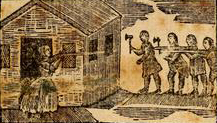 |
||||||||||||||
|
||||||||||||||
Lawrence Waters and Anna Linton |
||||||||||||||
Watertown, Middlesex County, Massachusetts Lancaster, Worcester County, Massachusetts |
||||||||||||||
|
Lawrence Waters and Anna Linton married in September, 1634/35 in Watertown, Middlesex County, Massachusetts. They owned eight acres bounded on the south by the highway, on the north by Nathaniel Bowman, on the east by Edward Lamb, and on the west by John Ellet. Lawrence Waters, Jr. was born in February 14, 1634/35. Sarah Waters Skeath was born on December 7, 1636. Mary Waters Davis was born on January 27, 1637/8. In 1638, Lawrence or Ann or both were warned in Watertown for having danced. The first inventory of Watertown taken about 1639, showed the Waters family had large land holdings. Their holdings included the original homestall, four acres of plowland in the further plain, four acres of meadow in the remote meadows, twenty five acres of upland, twelve acres of upland beyond the further plain, and a farm of 105 acres of upland. The first child named, Rebecca Waters was born in 1639/40. She died as an infant in 1640. Daniel Waters was born on February 6, 1641/42. Stephen Waters was born on February 24, 1643. Rebecca Waters Whitcomb was born in February, 1643/44 The second inventory of land in Watertown was taken in 1644. It showed the Waters family had same land holdings except the 105 acres, which was replaced by a one acre meadow in Patch Meddow, bounded with common land. The four acres of plow land was described as bounded on the east by Thomas Bartlett, on the west by Garret Church, on the north by the highway, and on the south by the river. In spite of these large land holdings, they disposed of it all except the original homestall and relocated to Lancaster along with Anna’s parents, the Lintons. A group of colonists called the Nashaway Company who were interested in commercial production sent them ahead to prepare the plantation. In Lancaster they were assigned seventeen acres on which they built a house which was about twenty rods above 'Sprague Bridge.’ It was the first house and lot number 18. The plantation was isolated and growth was slow. Adam Waters was born in 1645. Joseph Waters was born on April 29, 1647. Twins Rachel and Jacob Waters were born on January 1, 1649. Joseph died within the month and Rachel was the first attested death in Lancaster. She died on January 31, 1649. In 1650 they had sold their original house in Lancaster to John and Elizabeth Hall. They moved a few rods to a 6 acre lot where they built another house. They owned nine acres of rich bottom land bounded on the north by Richard Linton's lot, 13½ acres of upland on the east side of Swan's Swamp, and 11 acres of rich bottom land lying on the east side of Penacook River. Samuel Waters was born on November 14, 1651. Joanna Waters was born on January 26, 1653. She died as a baby on February 24, 1654. In 1654 their estate was rated at 277 pounds and they drew lot number four of eleven acres in the second division of meadows. Ephraim (Ephram) Waters was born on November 27, 1655. He died when he was three years old on April 17, 1659 in Lancaster. On September 8, 1657 a committee of three ordered the Selectmen to lay out additional land for Lawrence Waters and they received additional land grants on February 5, 1659. There was a garrison on the Waters property during King Philip’s War. In 1659 her father gave them 15 acres in Lancaster. On August 11, 1666 Lawrence and Anna gave their son Stephen one half of the second division land on Four Mile Brook between Wataquadock Hill and Long Hill, together with 4 acres of second division meadow and also fifty pounds of town rights. After the massacre of August 22, 1675, Lawrence and Ann, and Samuel with his wife and two children, found shelter in Charlestown, where their son Stephen became responsible to the authorities for them because Lawrence was blind. Sarah and John Skeath were killed in the massacre of 1697. Indigenous warriors attacked the town of Lancaster in February, 1676 and stormed the garrison where settlers had taken refuge. Mary Rowlandson, who was taken captive, described what happened in her famous narrative.
Survivors of the attack took shelter in and near two fortified houses or garrisons, one of them on the land of Lawrence Waters. Ann died in 1680 during the abandonment of the town and Lawrence died in 1687 after the re-settlement. On May 28, 1684 Lawrence was taxed in Lancaster as an out of town resident 1.3.5 for the meeting house and 1.17.0 for the minister. In 1697 Samuel's wife, Mary lost her parents, two sisters, and two children of her brother Nathaniel in an Indian raid.
|
|
||||||||||||
|
||||||||||||||
|
||||||||||||||
|
©Roberta Tuller 2025
|
||||||||||||||

